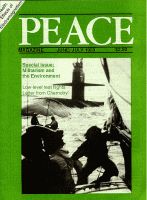
Peace Magazine Jun-Jul 1989, page 25. Some rights reserved.
Search for other articles by John Bacher here
Miles Golstick, Wollaston: People Resisting Genocide Montreal: Black Rose 1987
This is one of the best handbooks for peace activists seeking to understand the connections between nuclear weapons and the nuclear fuel cycle, the assault on ecosystems, and the colonization of Canada's native peoples. Well-structured, it includes chapters on "The People," "The Mines," "The Resistance," and "International Solidarity."
"The People" chapter portrays a people struggling to reclaim the integrity of their culture and harmony with their lands after over 200 years of European domination. He notes that the Dene had no name for uranium until a Dene elder in 1977 coined a phrase, "dada-thay," meaning "death rock." Unlike other parts of Canada, the Roman Catholic Church here still cooperates with an oppressive colonialism, as shown in the sketch of priest Jean Megret, who blessed the nuclear fuel cycle with the observation, "You just have to trust the people in charge." Traditional Indian spirituality is still disparaged by the Church as witchcraft. The author, Miles Goldstick, includes an exact copy of Treaty No. 10 that rules the Dene here, noting that its validity could be challenged, and reveals the story of how the reserve was obtained under it without any community consultation, thereby splitting the village in two.
Goldstick calls Saskatchewan the "Saudi Arabia" of the uranium industry. His compelling portrait shows the environmental damage done by every uranium mine in the province, including a shocking photograph of outlet pipes carrying radioactive wastes in a lake from the Beaverlodge uranium mine in Uranium City. In that town, the school, most of the streets and buildings, including its only hospital, were all built on radioactive sand. The confusing uranium mining/ nuclear weapons connection is meticulously explained by Goldstick. He notes that depleted uranium, a by-product of the refining process, is used for such varied purposes as uranium bullets and the casing for nuclear bombs. Saskatchewan uranium exported to Germany and Finland even aids the Soviet arsenal, as this is sent to an enrichment plant in Riga, Latvia. Uranium exported to France cannot be separated into peaceful and military purposes; the French atomic energy commission, which is part-owner of the Cluff Lake mine, even manufactures and tests nuclear weapons.
the voices of the Indians resisting the Wollaston Lake mine are heard; in interviews they explain their motives for a 1985 blockade that stopped uranium shipments from the Rabbit Lake mine. Showing political divisions without lapsing into partisanship, Goldstick reprints in full a speech by the NDP's Bill Blaikie, M.P., supporting the blockade but deploring the former Saskatchewan NDP government's complicity in assisting the French to "blow up innocent little islands in the Pacific." One of Goldstick's most disturbing points is that a major reason for the breaking of the blockade was the support of uranium mining by SINC (Saskatchewan Indian Nations Corporation), which provides security guards at the mines; it had been urged by the NDP to give Indians more involvement in the uranium mining industry.

Peace Magazine Jun-Jul 1989, page 25. Some rights reserved.
Search for other articles by John Bacher here